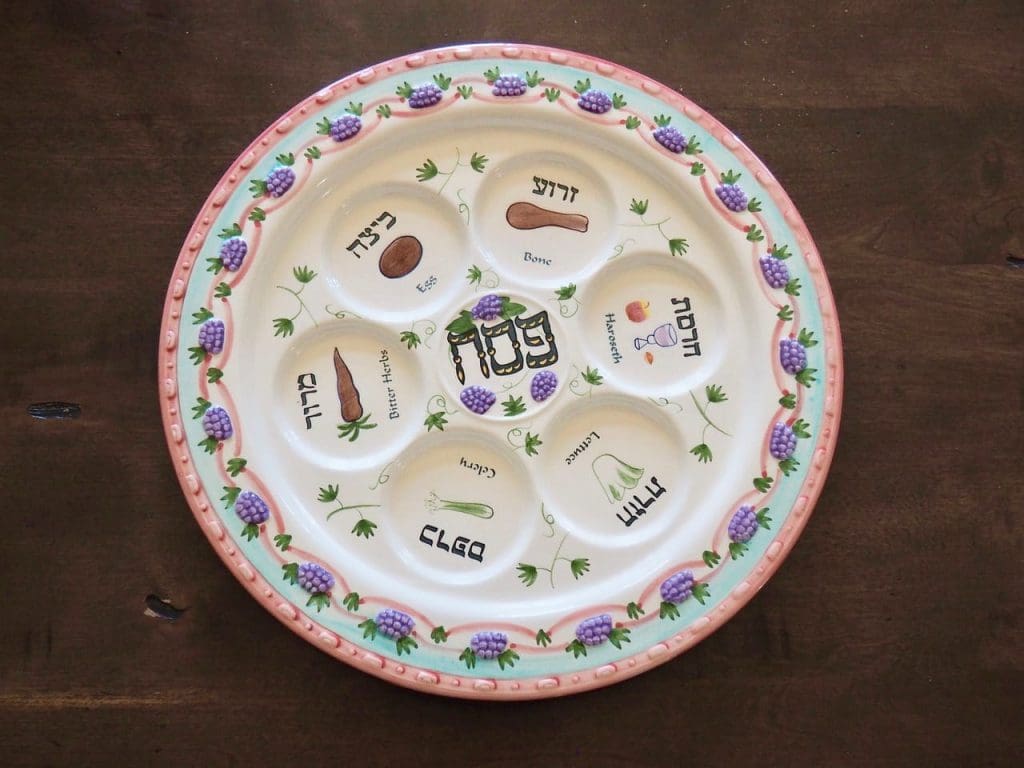The seder plate carries the story of Passover – the most celebrated religious holiday in the Jewish calendar. It features at every Passover celebration as families and friends gather around the Seder table to recall the story of Passover.
The core meaning behind the Seder plate hasn’t altered, but designs have adapted over the years to create beautiful and intricately designed plates that are a work of art. Keep on reading to explore the history of the Seder plate and its place in modern Jewish culture and religion.
The History Of The Seder Plate
The first recollection of a Seder plate is a basket called a Ke’arah in 1000 AD – but it wasn’t until the 16th century in Spain and Italy that Seder plates made from wood, porcelain, and copper began to appear. But it isn’t necessarily the origin of the Seder plate that’s important; it’s how the meaning behind it has adapted over the years. The Seder meal as we know it today was first mentioned in the Mishnah, which mentions familiar elements of the Seder meal we know today, like the sacrificial lamb, bitter herbs, and unleavened bread.
Rituals have changed over the years, which means so has the Seder plate. For example, the sacrificial lamb’s offering changed to a shank bone.
How It’s Used In Modern-Day Celebrations
Passover celebrations will always include a Seder meal, at a Seder table, with a Seder plate. The Seder meal is a sacred ritual, with the first and second night of Passover hosting the biggest celebrations. The Seder plate will have six spaces for the traditional Passover foods – this link to the web Israeli Judaica shows some great examples. The foods on a Seder plate include:
- Shank bone (zeroa)
- Boiled egg (beitzah)
- Bitter herb (maror)
- Vegetable (karpas)
- Sweet paste (harozet)
The Seder plate will take center stage at the table, alongside the Haggadah, three pieces of Matzo, a cup ready for wine for each guest, and the cup of Elijah. The Seder plate is used to bring people together, with each of the Passover foods telling a story. The shank bone is the sacrificial lamb; the bitter herbs represent the bitterness of the suffering, and the sweet paste represents the sweetness of freedom.
While the Seder plate design may have changed over the years, the meaning behind the celebration still remains the same.
Beautiful Seder Plate Designs
The best part about modern-day Seder plates is the designs. Artists and craftspeople have utterly changed the simplistic design of the Seder plate – although there are plenty of traditional dishes available online – and turned them into pieces of art.
One of the best modern adaptations is the Aleph-Bet Seder plate. The artist has used a cunning design that features alphabet style imprints into the dish for each delicacy. It’s simple, elegant, and represents the story of Passover perfectly. The Corian Seder plate is another simply sophisticated design. Featuring a porcelain white simple design – this plate design needs no explanation. Google them both to find examples and further adaptations.
The Seder plate – like the menorah for Hanukkah and the shofar for Rosh Hashanah – is instrumental to the modern-day celebrations. It brings people together, tells a story, and becomes the focal point of Passover. Jewish religious holidays often have items like the Seder plate with deep meaning attached.
The New Jersey Digest is a new jersey magazine that has chronicled daily life in the Garden State for over 10 years.
- Staffhttps://thedigestonline.com/author/thedigeststaff/
- Staffhttps://thedigestonline.com/author/thedigeststaff/
- Staffhttps://thedigestonline.com/author/thedigeststaff/
- Staffhttps://thedigestonline.com/author/thedigeststaff/


